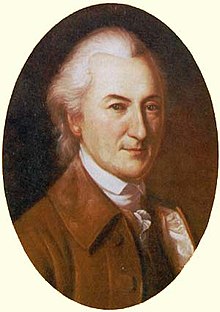
Back جون ديكنسون (سياسي) Arabic جون ديكينسون ARZ Con Dikinson Azerbaijani جان دیکینزون AZB John Dickinson Czech John Dickinson (Politiker) German John Dickinson Esperanto John Dickinson Spanish جان دیکینسون Persian John Dickinson Finnish
John Dickinson | |
|---|---|
 Portrait, 1780 | |
| 5th President of Pennsylvania | |
| In office November 7, 1782 – October 18, 1785 | |
| Vice President | James Ewing James Irvine Charles Biddle |
| Preceded by | William Moore |
| Succeeded by | Benjamin Franklin |
| 5th President of Delaware | |
| In office November 13, 1781 – January 12, 1783 | |
| Preceded by | Caesar Rodney |
| Succeeded by | John Cook |
| Continental Congressman from Delaware | |
| In office January 18, 1779 – February 10, 1781 | |
| Continental Congressman from Pennsylvania | |
| In office August 2, 1774 – November 7, 1776 | |
| Personal details | |
| Born | Nov 2 Jul./Nov 13Greg., 1732[note 1] Talbot County, Province of Maryland, British America |
| Died | February 14, 1808 (aged 75) Wilmington, Delaware, U.S. |
| Resting place | Friends Burial Ground in Wilmington, Delaware |
| Political party | Democratic-Republican |
| Residence(s) | Kent County, Delaware, Philadelphia, and Wilmington, Delaware |
| Occupation | Enslaver/planter (until 1777), abolitionist (after 1777), lawyer |
John Dickinson (November 13, [O.S. November 2] 1732[note 1] – February 14, 1808), a Founding Father of the United States, was an attorney and politician from Philadelphia, Pennsylvania, and Wilmington, Delaware. Dickinson was known as the "Penman of the Revolution" for his twelve Letters from a Farmer in Pennsylvania, published individually in 1767 and 1768, and he also wrote "The Liberty Song" in 1768.
As a member of the First Continental Congress, where he signed the Continental Association, Dickinson drafted most of the 1774 Petition to the King, and then, as a member of the Second Continental Congress, he wrote the 1775 Olive Branch Petition. Both of these attempts to negotiate with King George III of Great Britain failed. Dickinson also reworked Thomas Jefferson's language to write the final draft of the 1775 Declaration of the Causes and Necessity of Taking Up Arms.
While in Congress, Dickinson served on the committee that wrote the Model Treaty, a template for seeking alliances with foreign countries, but he opposed independence from Great Britain. He either abstained or was absent from the vote on the Declaration of Independence and refused to sign the document after its passage. Nevertheless, Dickinson wrote the first draft of the 1776–1777 Articles of Confederation and Perpetual Union and served as a militia officer during the Revolution. He later was elected president of the 1786 Annapolis Convention, which called for the Constitutional Convention of 1787, and as a delegate from Delaware, he signed the United States Constitution.
One of the wealthiest men in the British American colonies, Dickinson served as president of Delaware (1781–1783) and president of Pennsylvania (1782–1785). Upon Dickinson's death, President Thomas Jefferson referred to Dickinson as, "(a)mong the first of the advocates for the rights of his country when assailed by Great Britain" and called him "one of the great worthies of the revolution."[1]
Together with his wife Mary Norris Dickinson, he is the namesake of Dickinson College, Penn State Dickinson Law, and the Dickinson Complex at the University of Delaware. John Dickinson High School in Wilmington, Delaware, was dedicated in his honor in 1959.
Cite error: There are <ref group=note> tags on this page, but the references will not show without a {{reflist|group=note}} template (see the help page).
- ^ "UD Library discovers Thomas Jefferson letter". University of Delaware. December 3, 2009. Retrieved December 5, 2009.
© MMXXIII Rich X Search. We shall prevail. All rights reserved. Rich X Search